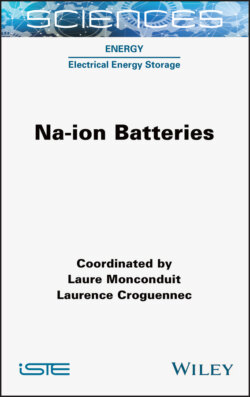Читать книгу Na-ion Batteries - Laure Monconduit - Страница 14
I.2.3. Electrolytes and the solid electrolyte interphase
ОглавлениеThe electrolytes are essential for the proper functioning of any battery technology, with an important focus to minimize interface electrolyte/electrode reactions and enhance both performance and safety. First studies surveyed electrolytes prepared using classical alkyl carbonates solvents and mixtures, in combination with different Na salts (Ponrouch et al. 2012). Their viscosity, ionic conductivity, thermal and electrochemical stability were evaluated to establish some intrinsic trends to identify the first electrolyte formulations with the widest range of applicability for NIBs.
More recently, IL, defined as room temperature molten salts and composed mainly of organic cations and (in)organic anions and presenting a huge versatility of structural variations, were proposed as major alternatives for the development of optimized electrolytes. Indeed, IL offer unique physical and chemical properties associated with low volatility that make them extremely interesting for the development of electrolytes with higher electrochemical and thermal stability. Chapter 5 will give the major trends for the IL-based electrolytes developed for NIBs.
The concept of solid electrolyte interphase (SEI), which is formed from the contact of the electrode with the electrolyte, was first introduced by Peled (1979) and then widely accepted in the LIB community, before being logically extended to NIBs as the nature of the electrodes and electrolyte are antecedent. Chapter 6 describes the SEI formation in NIBs, which has to be passivating for the electrode surface and stable upon cycling to get good cycling performance. Although the SEI layer and its formation have been intensely investigated during the last decades, even in LIBs it is still considered to be misunderstood being strongly dependant on a series of parameters such as the composition of the electrolyte, the nature of the electrodes and the cycling conditions. Moreover, regarding NIBs, to date there are only a few reports addressing the fundamental aspects of SEI chemistry. Recent works showed than even though the knowledge coming from LIBs is helpful for understanding the electrolyte/electrode interfaces modifications, a direct transfer of knowledge from LIBs to NIBs is not guaranteed. Indeed, many parameters have to be taken into account: the higher standard potential of Na+/Na than Li+/Li (~0.33 V), the higher solubility of carbonates from the SEI in NIBs, the lower desolvation energy of Na+, the larger coordination shell of Na+, the higher water reactivity of Na+, etc. (Eshetua et al. 2019). These different features tailoring the nature and stability of the SEI in NIBs will be described in detail in Chapter 6.
